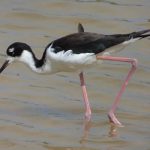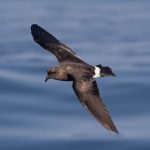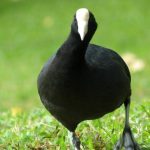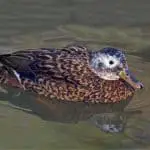Common Name: Northern Pintail
Scientific Name: Anas acuta| Size | Diet | Range in Hawaii | Status in Hawaii |
|---|---|---|---|
| 20 in. - 30 in. | insects, crustaceans, mollusks, and aquatic invertebrates | Oahu and Big Island | Least Concern |
The Northern Pintail (Anas acuta) is a beautiful and elegant duck species found in many parts of the world. With its long, graceful neck and distinctive pointed tail feathers, the Northern Pintail is a striking sight to behold. While this species is not native to Hawaii, it has been spotted in the state on rare occasions. In this article, we will explore the fascinating characteristics and behaviors of the Northern Pintail and its presence in the Hawaiian Islands.
Northern Pintail
Appearance
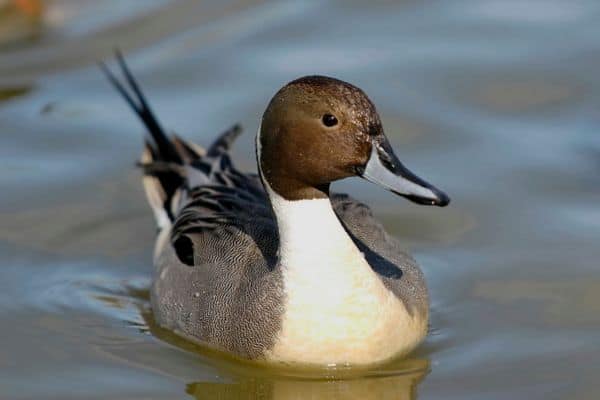
The Northern Pintail is a striking migratory bird that boasts a unique and elegant appearance. It is considered a medium-sized dabbling duck with a length ranging from 20 to 30 inches (50 to 76 centimeters) and a wingspan of approximately 28 to 35 inches (71 to 89 centimeters).
What sets the Northern Pintail apart is its slender neck, which gracefully extends from its sleek, elongated body. The male Northern Pintail sports a distinctive plumage, characterized by a chocolate-brown head, a white breast, and a long, pointed tail that extends well beyond its body.
Its back is adorned with gray feathers, while its sides feature intricate black and white patterns. In contrast, the female Northern Pintail boasts a more subtle appearance, showcasing a mottled brown body with hints of gray and a shorter tail.
Diet
The Northern Pintail has a versatile and adaptable diet that allows it to thrive in various habitats. As a dabbling duck, it primarily feeds by tipping its head underwater or by upending its body, reaching for food near the surface without fully submerging. The diet of the Northern Pintail consists of a diverse range of plant matter and invertebrates.
Plant matter forms a significant portion of the Northern Pintail’s diet. It feeds on aquatic vegetation such as seeds, stems, leaves, and roots of various submerged plants. It shows a particular affinity for consuming the seeds of sedges, grasses, and aquatic plants, utilizing its specialized bill to strain and filter out small particles.
In addition to plant material, the Northern Pintail also seeks out small invertebrates, including insects, crustaceans, mollusks, and aquatic invertebrates. It may forage in shallow waters, mudflats, or wetland edges, where it can find an abundance of insect larvae, beetles, snails, and other small organisms.
During the breeding season, the Northern Pintail’s diet may shift slightly to accommodate the nutritional needs for egg production and rearing of ducklings. At this time, it may consume more protein-rich food sources, such as aquatic insects and small crustaceans, to support the growing demands of its offspring.
Nesting
The Northern Pintail selects diverse wetland habitats for nesting, such as marshes and lakes. The female builds a shallow nest near the water’s edge, using grass and leaves for lining.
After laying about 6 to 10 eggs, she incubates them for 22 to 24 days. Once hatched, the ducklings quickly leave the nest, guided by the female to find food sources in the water. The Northern Pintail’s nesting behavior showcases adaptability, as they choose concealed locations and ensure the survival of their offspring through attentive care and guidance.
Behavior
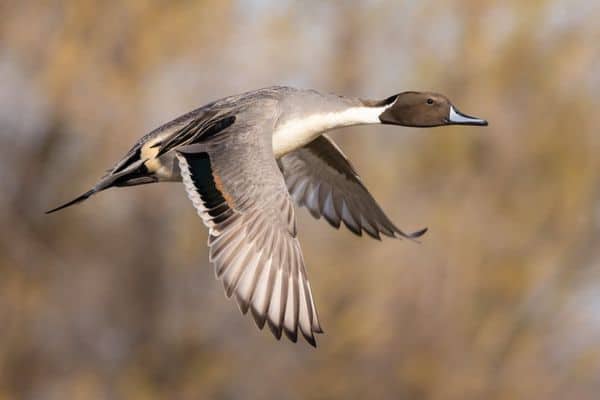
The Northern Pintail displays a fascinating range of behaviors that highlight its adaptability, social dynamics, and remarkable migratory instincts. These birds are known for their extensive migrations, covering vast distances across continents in search of suitable habitats and food sources.
They navigate along established flyways and often form large flocks during migration, demonstrating their strong sense of navigation and cooperation. As dabbling ducks, Northern Pintails primarily feed by tipping their heads underwater or upending their bodies to reach food near the water’s surface.
These flocks engage in synchronized swimming, feeding, and resting, creating captivating scenes of collective movement. During the breeding season, Northern Pintails form monogamous pairs, and males perform elaborate courtship displays.
These displays involve stretching their necks, shaking their heads, and flapping their wings while emitting distinctive calls. Courtship rituals play a vital role in pair formation and strengthening the bond between mates.
When it comes to nesting and parental care, Northern Pintails select wetland habitats and construct shallow nests near water bodies. The female takes on the primary responsibility of incubating the eggs and caring for the ducklings after they hatch.
Males may leave the breeding grounds earlier, joining molting flocks to undergo a period of feather renewal. Communication among Northern Pintails includes a range of vocalizations.
Males produce soft whistles or a series of melodious notes during courtship displays, while females emit softer quacking sounds. Body movements, head nodding, and tail wagging also serve as means of communication.
Habitat
The Northern Pintail is a highly adaptable duck species that can be found in a diverse range of habitats across its extensive range. These habitats typically include wetland areas, both natural and man-made, that provide suitable conditions for feeding, nesting, and resting.
During the breeding season, Northern Pintails prefer nesting in wetland habitats with abundant vegetation, such as marshes, ponds, and lakes. They look for areas that offer a combination of shallow water, emergent plants, and ample cover to conceal their nests. These habitats provide them with the necessary resources for successful reproduction and the rearing of their young.
In non-breeding seasons and during migration, Northern Pintails can be found in a variety of wetland and aquatic habitats, including coastal estuaries, lagoons, salt marshes, and agricultural fields. They are known to take advantage of temporary and seasonal wetlands, making use of flooded areas or areas with high water levels for feeding and resting.
Range
The Northern Pintail is not native to Hawaii, but it has been spotted on rare occasions on both Oahu and the Big Island of Hawaii. These sightings usually occur during the winter months when the bird migrates south from its breeding grounds in northern North America.
Conservation Status

Globally, it is classified as a species of “Least Concern” by the International Union for Conservation of Nature (IUCN), indicating that it is not currently facing immediate risks of extinction. However, in some regions, such as Europe, the Northern Pintail is listed as “Vulnerable” due to specific conservation concerns.
Interesting Facts
1. Impressive Migrants
Northern Pintails are remarkable long-distance migrants, known for their extensive journeys across continents. They travel along established flyways, covering thousands of miles during their annual migrations.
2. Striking Plumage
Male Northern Pintails are known for their elegant appearance. They have long, slender necks, a chocolate-brown head, and a white breast with intricate gray and black patterning. Their elongated central tail feathers give them a distinctive look.
3. Flexible Nesters
These ducks nest in a variety of wetland habitats, including marshes, ponds, and lakes. They construct shallow nests lined with grass and leaves near the water’s edge, providing camouflage and protection for their eggs.
4. Social Flocks
Outside the breeding season, Northern Pintails gather in large flocks, often mixing with other waterfowl species. These flocks engage in synchronized swimming and feeding, creating captivating displays of collective movement.
Frequently Asked Questions
1. How long do Northern Pintails live?
On average, Northern Pintails have a lifespan of around 10 years in the wild. However, some individuals have been known to live up to 15 years or more.
2. How fast can Northern Pintails fly?
Northern Pintails are capable of flying at impressive speeds. They can reach speeds of up to 65 miles per hour (104 kilometers per hour) during migration, allowing them to cover long distances efficiently.
3. Do Northern Pintails have any predators?
Yes, like many bird species, Northern Pintails face predation threats. Some of their main predators include larger birds of prey such as eagles, hawks, and owls. They may also be preyed upon by mammalian predators like foxes and raccoons.
4. Can Northern Pintails be kept as pets?
In most cases, it is not recommended to keep Northern Pintails as pets. They are wild migratory birds and have specific habitat and dietary requirements that are challenging to meet in a captive setting. It is important to appreciate and conserve them in their natural habitats.

